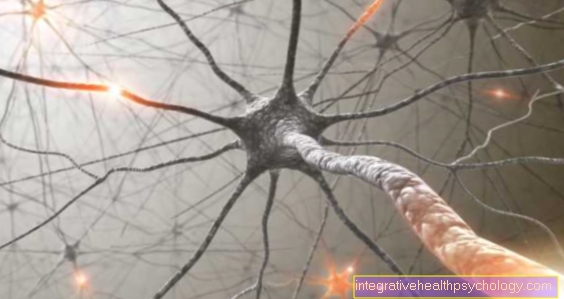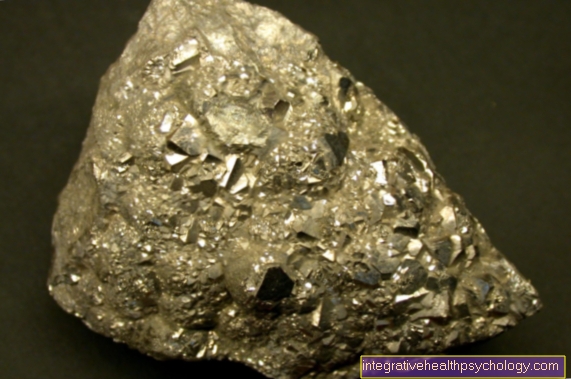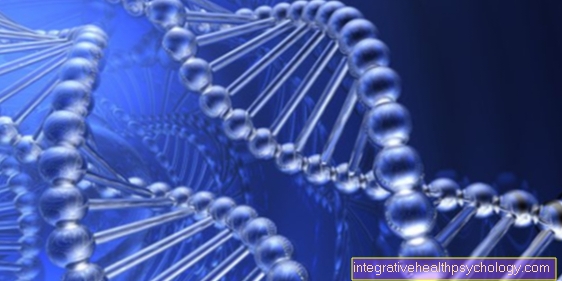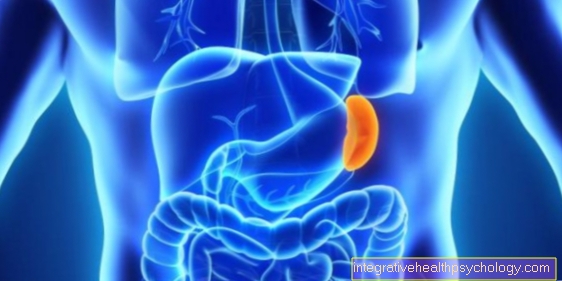Blood-brain barrier
introduction
The blood-brain barrier - many have probably heard this term before and have a rough idea of what it is and what it is used for.
Because the name already gives it away, it is a barrier between the bloodstream and the brain, more precisely the cerebral fluid (also called nerve water, Latin: Liquor).
But what exactly is this barrier made of, how does it work, what holds it back and what do we need it for anyway? These questions should be clarified below.
General

The blood-brain barrier is therefore a barrier between the small blood vessels in the brain and the nerve water.
The nerve water (lat. Liquor) is formed by the choroid plexus and flows around the central nervous system (CNS), consisting of the brain and spinal cord. These are surrounded by three meninges. The water-clear nerve water flows between the inner and middle meninges, in the so-called subarachnoid space. It is produced in more internal areas of the brain. Here there is a system of cavities, the so-called ventriculi, in which the nerve water is formed by filtration from the blood.
Ultimately, however, the liquor contains far fewer cells and proteins than the blood.
Every day new liquor is formed and at the same time old liquor is reabsorbed via veins or lymph vessels.
The main function of the nerve water is to cushion the CNS and thus protect it from external mechanical influences.
In addition, the fact that the brain swims in the liquor significantly reduces its weight.
In addition, it plays a role in the nutrition of the nerve cells.
The function of the blood-brain barrier is to keep the composition of the nerve water constant so that the milieu of the nerve cells is subject to as few fluctuations as possible. This is possible because the barrier controls the exchange of substances between blood and liquor. It does not allow harmful substances such as poisons, pathogens and hormones through. On the other hand, it lets in nutrients such as sugar, metabolic products of the nerve cells are let out and can be transported via the blood to the liver and finally disposed of.
However, the blood-brain barrier does not exist in all areas of the brain. Certain organs are dependent on contact with the blood. For example, there is an area in the brain that measures the components of the blood and, if necessary - if there are toxic substances in the blood - triggers a vomiting reflex.
Other organs, in turn, produce hormones that have to get into the blood so that they can be distributed in the body and have their effect elsewhere.
construction
The blood-brain barrier is simply aus the walls of the small cerebral vesselswhich are structured differently here than in the rest of the body.
They play an important role Endothelial cells. These are the cells that make up the walls of tiny blood vessels inside brain form. These so-called Capillaries have - in contrast to larger vessels in the circulation - only one single layer wall.
While the walls of large vessels consist of three layers (two layers of connective tissue and in the middle a layer of muscles to regulate the diameter), small capillaries only have the innermost layer - the endothelial layer. These endothelial cells are a so-called Basal lamina on (a thin layer of proteins) and encircle the vessel.
In the rest of the body, i.e. outside the brain, is the endothelium of the blood vessels not perfect tight. Small gaps remain between the endothelial cells.
In this way, water and solutes and for example Nutrients from the blood into the surrounding tissues reach.
Inside the brain however, the endothelial cells of the vessels form a quasi one gapless wall. The individual endothelial cells are very closely connected to one another via so-called tight junctions.
This endothelial layer cannot be penetrated that easily - except by fat-soluble substancesthat can diffuse through the cell membrane because it consists of fat itself, or through active transport mechanisms such as pumps or channels.
The capillaries of are embedded in the tissue of the brain Astrocytes enveloped. Astrocytes are next to the Neurons (Neurons) the most important cell type in the brain. Among other things, they are responsible for nourishing the neurons. Their processes are also part of the blood-brain barrier.
Permeability
Nutrients such as sugar (glucose) or Electrolytes how sodium and potassium become active through the with the help of pumps or transporters Endothelium managed, water in turn can through certain channels (Aquaporins) overcome the blood-brain barrier.
Certain Hormones - especially stress- and Sex hormones - can diffuse through the blood-brain barrier and affect the brain.
Also liposoluble gases like oxygen and carbon dioxide can overcome the endothelial layer without special tools. Likewise other fat-soluble substances such as alcohol, nicotine and heroin. This way, the Addictive substances work in the brain.
The more a drug is soluble in fat, the more it can penetrate the CNS. These drugs include, for example Psychotropic drugs, anesthesia-, sleep- and Sedatives. At Antibiotics on the other hand, a poor fat solubility (so instead a good solubility in water) respected as they neurotoxic are.
Fabrics that potentially dangerous for the brain are held up by the blood-brain barrier.
However, there are exceptions. bacteria and Viruses the triggers one meningitis, i.e. meningitis, or that Human immunodeficiency virus (HIV) cannot be stopped by the barrier.
Still other substances that are actually needed in the CNS, but which cannot cross the barrier either, have to be regenerated within the brain. An example of such a substance is cholesterol. The astrocytes thus produce cholesterol themselves, as it is essential for the production of the Myelin sheaths the neuron is (Mylin sheaths, in turn, are an indispensable sheathing for nerve cells).
Another important point are metastatic Tumor cells. Especially the cells of Bronchial carcinoma (Lung cancer), Breast cancer (Breast cancer) and malignant melanoma (Skin cancer) sprinkle hematogenous (so about the blood) into the brain, despite the blood-brain barrier, where there are metastases, i.e. secondary tumors can form.
The barrier poses a problem here because it allows the medication of the chemotherapy reach the metastases more difficult.
In addition, the permeability of the blood-brain barrier can be reduced by tumor diseases, Cerebral infarctions, inflammatory processes or rare genetic diseases (e.g. deficits of the above-mentioned channels). As a result, substances that should actually be filtered can get into the liquor, or nutrients such as glucose, which the brain actually needs, no longer reach it.
Changes in the blood-brain barrier in multiple sclerosis
Structural changes in the area of the blood-brain barrier lead to a loss of integrity (intactness of the blood-brain barrier), which promotes the development of various diseases such as multiple sclerosis (MS).
In multiple sclerosis it occurs as a result of Crossover of various immune cells (White blood cells and phagocytes) into the brain, to inflammatory, demyelenizing processes in the central nervous system (brain and spinal cord).
These demyelenizing processes lead to the loss or breakdown of the myelin sheath (myelin sheath of the nerve cells in the central nervous system, comparable to the isolation of a line), which leads to various neurological symptoms (such as visual acuity disorders).
The exact process by which white blood cells and phagocytes cross the blood-brain barrier is not yet fully understood. A malfunction is fundamental for the development of multiple sclerosis, which is characterized, among other things, by a reduced formation of cell contacts (comparable to a dense barrier).
In the context of multiple sclerosis, specialized cells of the blood-brain barrier produce different types of signaling molecules (molecules that mediate processes). With the help of this, the passage of various immune cells through the blood-brain barrier into the brain is possible.
General information on the topic can be found here: multiple sclerosis
Changes in the blood-brain barrier from alcohol
In addition to drugs and certain medications, alcohol is able to penetrate the selective filter barrier of the brain, the blood-brain barrier.
Alcohol or excessive alcohol consumption leads to a disrupted integrity (intactness of the blood-brain barrier), whereby the Development of neurodegenerative diseases (in which nerve cells perish), is favored.
Regular alcohol consumption and its metabolic products lead to it structural changes in the blood-brain barrier.
This means that regular and excessive alcohol consumption makes the selective filter barrier more permeable for toxic and disease-causing substances. This brings about structural and functional changes in the central nervous system (brain and spinal cord).
Changes in the blood-brain barrier caused by drugs
Despite the selective protective function of the blood-brain barrier against the penetration of non-endogenous substances into the brain via the blood, it is possible for certain substances to overcome the selective filter of the blood-brain barrier.
In addition to drugs and alcohol, certain medications are also able to cross the blood-brain barrier. The group of drugs that can penetrate the blood-brain barrier includes antidepressants, anti-epileptics (such as gabapentin), and the precursor of the messenger substance dopamine, L-dopa (levodopa). Dopamine is a messenger substance that is partly responsible for feelings of happiness or concentration, for example.
Dopamine is mainly used for therapeutic drug treatment of Alzheimer's disease and, in its actual form, cannot cross the blood-brain barrier. In order to transport dopamine through the blood-brain barrier into the brain, one uses a precursor of dopamine, L-dopa (levodopa). Once in the brain, the L-Dopa is converted to dopamine by the body's own molecules in order to develop its effect.
Overcoming the blood-brain barrier and improving the permeability of the blood-brain barrier for drugs for the treatment of neurodegenerative diseases such as Alzheimer's or amyotrophic lateral sclerosis (AS), is still a current subject of medical research.
Conclusion
The blood-brain barrier is therefore indispensable for that safety and Function maintenance of neurons. Sometimes it becomes the Effectiveness of drugs difficult. If it doesn't work properly, it can lead to a number of things neurological deficits to lead.





























